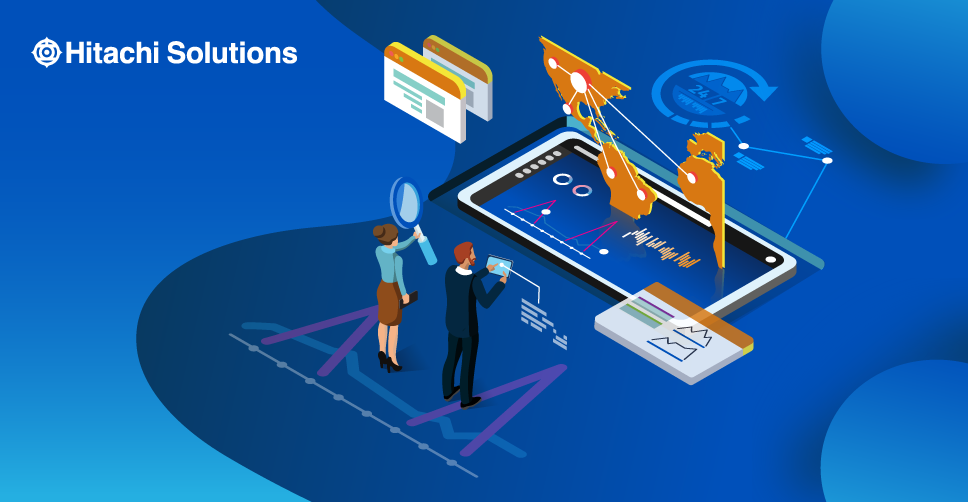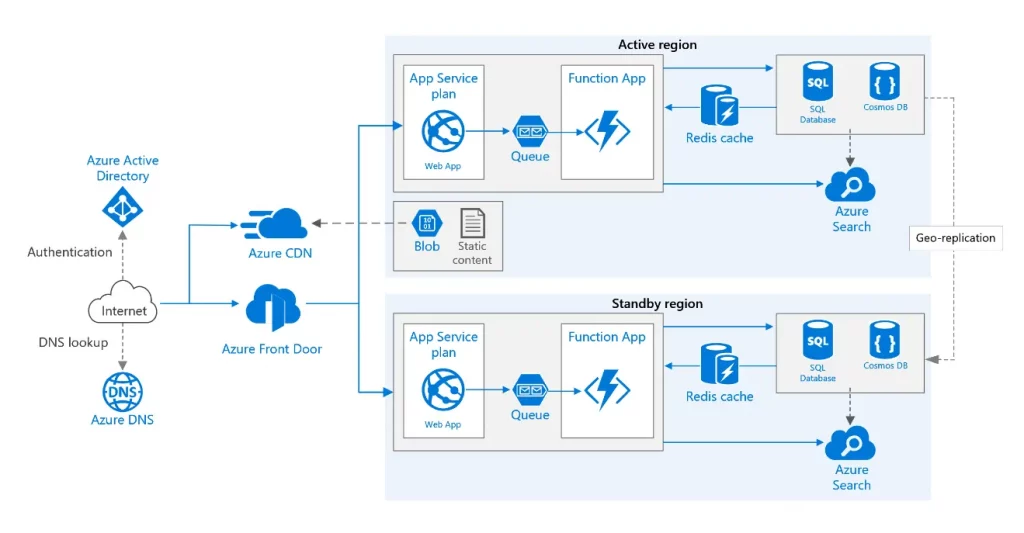

Proactive D365 F&O Monitoring and Alerting
4-6 Weeks │ Price Starting at $1.5K/month* USD * plus one-time setup fees
Download the OfferAzure monitoring can be challenging, given how dynamic and distributed the average Azure cloud environment is. Fortunately, by understanding the various components that exist within such an environment and the different capabilities to look for in Azure monitoring solutions, you can overcome the inherent complexities and develop a winning Azure monitoring strategy.
The Building Blocks of an Azure Environment
Although each Azure environment is unique, they all consist of the same basic components. These include:
- Virtual Machines: A virtual machine (VM) is a software program that emulates a physical computer; like physical computers, VMs are capable of running applications and operating systems. VMs, also called “guests,” run in a host environment — in this case, an Azure cloud environment. According to Microsoft, VMs are “just one of several types of on-demand, scalable computing resources Azure offers.”
- Networking Components: Every Azure environment includes a variety of networking components, including a virtual network, a network interface card, Azure DNS, an application gateway, a VPN gateway, a traffic manager, ExpressRoute, and a load balancer.
- Database Service(s): Every Azure environment must connect to one or more cloud database services in order to access data. Some examples of possible Azure database services include Azure SQL Database, Azure Database for PostgreSQL, Azure Database for MySQL, Azure SQL Managed Instance, and Azure Cosmos DB.
- Web Service(s): A web service refers to any website hosting offering in Azure where Microsoft manages the underlying infrastructure, thereby enabling customers to focus on code and functionality. The most common example of a web service in Azure is Azure App Services.
- Application Components: Each typical Azure application includes multiple components, such as Logic Apps, Automation Accounts, Storage Accounts, Log Analytics for storing logs and metrics, and Application Insights for performance monitoring.
To see an example of a standard Azure environment, please refer to the image below:

This example architecture is for an application deployed to active and standby regions. As you can see, we’ve used Azure Front Door to route traffic to the currently active region. Each region has a Web App front end to handle web requests, a Function App to provide business logic and processes, various databases and storage, and an Azure Search configuration to support advanced search functionality.
The purpose of Azure monitoring is to gain end-to-end visibility across your entire software stack and ensure that the various components within your Azure environment work as intended. To that end, Azure monitoring tools are designed to collect performance data from each component, analyze that data to identify bottlenecks or other performance issues, run diagnostics, and troubleshoot as needed.
Azure Monitoring: Sometimes Easier Said Than Done
Cloud environments — Azure environments, included — are notoriously difficult to monitor for a few reasons. For starters, cloud environments are incredibly complex because they consist of multiple different resources, each of which has its own correct way of monitoring. An average-sized Azure deployment might include 100 different resources and 10–15 resource types, which can make it challenging to know whether you’re using the correct monitoring techniques and metrics.
Then there’s the fact that cloud environments are highly distributed, meaning they connect to multiple different data sources. The more data sources your Azure environment is connected to, the greater the volume of incoming data, and the more information there is to sift through in order to diagnose and troubleshoot performance issues. Cloud environments are also highly dynamic, meaning that they’re frequently subject to change; in an Azure environment, new tools and services come and go on a regular basis, which can make it difficult to stay on top of monitoring.
Finally — and this is something of a more recent occurrence — cloud environments are often managed by multiple teams. This means that there could be many individuals making changes to the environment and deploying additional resources at any given point in time, adding to its complexity and making Azure monitoring even more trying.
Why You Need to Monitor Your Azure Environment
Monitoring an Azure environment may be challenging, but it’s far from impossible. In fact, there are a great many benefits to Azure monitoring, including, but not limited to:
- More streamlined cloud migrations and product rollouts
- Up-to-the-minute reporting on important KPIs and metrics
- End-to-end infrastructure visibility
- Enhanced application performance
- Improved operational efficiency
- Optimized Azure infrastructure
- Unified monitoring for public, private, and hybrid cloud environments
- Greater collaboration across teams
- Reduced downtime through proactive detection and resolution
- Increased business continuity and availability
- Better overall experience for clients accessing cloud services
The 5 Capabilities Every Azure Monitoring Solution Should Include
The key to overcoming many of the obstacles we’ve mentioned is to invest in the appropriate Azure monitoring solutions. There is a vast array of Azure monitoring tools on the market today — more on that in just a bit — but any solution worth its salt should include these basic capabilities:
- Data Aggregation and Storage: An Azure monitoring solution should securely store all data — regardless of its source — within a single, centralized repository so that it’s readily available and easy to review. It’s important that this repository be scalable so that it can grow along with your Azure environment and support data bursts.
- Data Ingestion: Azure environments pull in massive quantities of data — so much, in fact, that data ingestion pipelines can sometimes collapse, and components fail under the pressure. It’s important that your architecture be designed in such a way that it can accommodate fluctuations in data volume so that all components within your environment continue to function as usual and that data can be made available for query.
- Data Processing: Once data is aggregated, ingested, and stored, it must be processed. Data processing essentially refers to anything your backend service of choice does to make data searchable and usable for analysis, such as rolling up metrics into different time granularities, tying metrics to the resources that generated them, and correlating related records from different sources. Data processing makes data analysis possible and provides additional context when alerts are generated.
- Data Analysis: One of the primary purposes of Azure monitoring is to proactively identify, troubleshoot, and resolve any issue within your environment that could interrupt business continuity. To that end, it’s imperative that you look for a solution that can drill down into data, run Azure performance diagnostics, and provide comprehensive analysis in the form of dashboards and data visualizations, so that you can more easily recognize anomalous behavior.
- Alerting: It goes without saying that your Azure monitoring solution should notify you as soon as it detects any issues, so that you can get to work resolving them before they have the chance to impact your business. A truly advanced solution will leverage machine learning and artificial intelligence to establish performance baselines for different components within your Azure environment and automatically trigger an alert in real time any time an application deviates from its baseline.
Solutions & Support, All in One
Though there are a great many Azure monitoring solutions available, each with their own unique benefits and drawbacks, few come backed by a team of highly trained and experienced cloud monitoring support professionals.
Hitachi Solutions Managed Services offers a comprehensive set of solutions and services designed to make Azure platform monitoring easy and efficient. With our centralized platform and easy-to-use portals and dashboards, you’ll be able to:
- View all activity within your Azure environment at a glance from a single pane of glass view
- Visualize highly granular data and custom metrics in real time
- Proactively prevent outages by reporting on metric forecasts
- Diagnose and resolve performance issues with greater speed and efficiency
- And more
Best of all, you’ll also receive comprehensive, 24/7 remote infrastructure monitoring from a dedicated team of technical experts. Find out how Hitachi Solutions can help ensure the security and continuity of your Azure environment — contact us today to get started.
Video: Taking Monitoring to the Cloud
Learn the top 5 monitoring tips for organizations moving to Azure.
https://play.vidyard.com/dxU7AVifjmbjSdSL4mXXSj.html?


